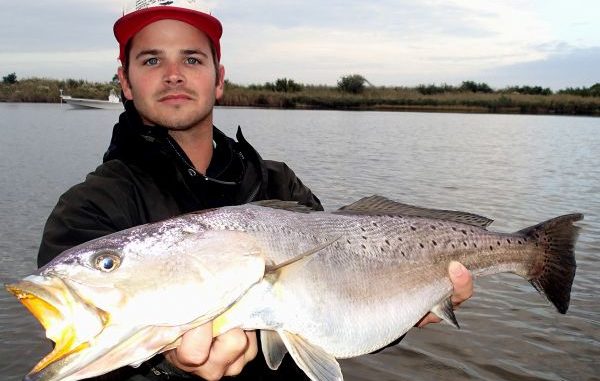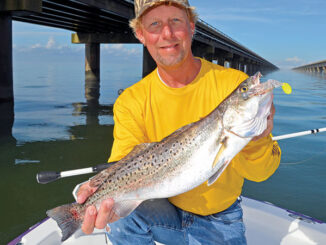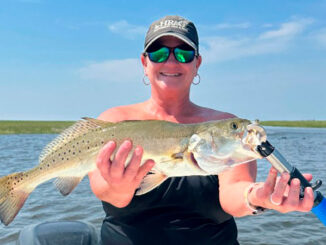
Lake Charles guide works the flats for trophy trout
Capt. Bruce Baugh kicked off wade-fishing season in style last week, netting some truly amazing speckled trout in just a two-hours span on Calcasieu Lake.
“It was a banner day for us,” said the 59-year-old angler who operates Tideline Charters. “Altogether, we had three over 8 pounds, three over 7 pounds and several over 5 and 6 pounds. And all the trout were released back into the lake.”
According to Baugh, last Friday was the day after a cold front arrived, and winds turned from north to east the night before.
“As a result, the tide brought water into the cove and the water table was above average,” he said. “Those big fish came in with that high water, and they were chasing mullet on a secluded shoreline near West Cove in the morning. The surface water temperature was 54 degrees.
“Although we caught those trout along with a few redfish in two hours, the feeding was quite aggressive for 90 minutes,” Baugh said. “Our trout ranged upward to 29 inches with nothing under 24 inches.”
Wade-fishing for Calcasieu Lake’s trophy trout is Baugh’s hallmark style of fishing, and he knows the secrets to success.
The angler picks shallow, hard shell flats and hardened mud flats, and initially transports the anglers as close as he can to his spots. Then they disembark from the boat in waders insulated to match the weather and water temperatures.
Popular areas to find wade-fishing locations in Calcasieu Lake include shorelines and other small coves in the West Cove area, as well as Turner’s Island in Turner’s Bay.
Anglers are forewarned, however, that shell flats and hard mud should be thoroughly tested for safety before wade-fishing.
“Waters can be too deep to wade on the east shorelines,” he said.
Another key to Baugh’s success with trophy specks on Lake Calcasieu is his skill with casting and working Paul Brown’s broke-back Corkys.
“We caught those fish on broke-back Corkys and topwaters,” he said. “The colors of the Corkys were pearl/black-back and pearl/chartreuse-back.
“The broke-back Corky can be used as a floater or a sinker, depending upon how it is worked and how the speckled trout react to its presentation.”
Usually it’s worked as a twitching, suspending plug in colder water temperatures, or it can be worked quickly as a topwater lure when water temperatures are at 60 degrees or above.
One of Baugh’s clients last week also worked a black Heddon Super Spook, which is usually dog-walked on the surface.
As for tackle, Baugh will use FINS 20-pound braided line with a 20-pound fluorocarbon leader cast from a Fish and Tackle Unlimited green rod.
“We’ll wade now through the cold winter months into the spring of 2014,” Baugh said. “These trophy specks have a tendency to school together in winter’s coldest months, a time I find is best to catch them.
“And it’s in some of the nastiest, coldest weather on the lake that we have taken trophy speckled trout, up to 10 pounds. Although conditions can be miserable, they sure can be great for an angler seeking to catch a personal best speckled trout in terms of length and weight.”
Baugh said it is a common mistake to think trophy speckled trout go deep when water temperatures get colder in the winter, especially when surface temperatures fall into the 40s.
“Many of these large trout will not migrate to deeper holes,” he said. “They’ll be found in shallow mud and shell flats ambushing mullet.”
He said their bellies often will be muddy because they’ve been so close to the flats waiting for their next meal to swim by.
Less fishing pressure is another reason to plan a trip during the coldest months, he said.
“Many of the guides and local anglers are hunting waterfowl and deer at this time of the year,” Baugh said.


